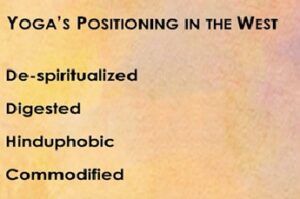
Part 1 of this series can be ‘accessed ‘ here. This is Part 2.
[dropcap color=”#008040″ boxed=”yes” boxed_radius=”8px” class=”” id=””]F[/dropcap]rom the standpoint of Westerners, Louise says she can empathize with the way in which Christianity has been rejected by them. When she was faced with existential questions, she found Swami Dayananda. He had a teaching methodology which could answer those questions in a way that it has kept her committed to the Sampradaya for a long time. She says that Swami Dayananda taught her how to think. She didn’t go to college and isn’t an academic but can clearly make out that most Westerners are not asking the right questions. They seem to reject the Judeo-Christian framework, but they don’t accept the eastern framework without appropriating it with their own concept of God.
The nature of reality which the Rishis discover doesn’t constitute a religion. We only agree with the appropriators to the extent need to be rejected.
She summarizes the video as self-deflection similar to colonial deflection. In this, the appropriator doesn’t accept that he is appropriating a certain concept from Hinduism, but he will attribute appropriation to Hindus first and then say that because Hindus have any way appropriated, it is all well for Westerners to do the same. The reason she says they made the video is perhaps to answer uncomfortable questions posed by many people about the origins of the Mantras. Rather than being honest, they have made Hinduism the original appropriator and seek to absolve themselves of appropriation.
I suggested that we should not be stuck in a certain vocabulary that is framed by the appropriators. The way they frame the problem is that there are religions and religious conflict. They claim that Hinduism is a religion and that all religions including Hinduism came later. Before the religions were some primordial practices and so forth. This is the vocabulary which needs to be rejected. Our approach should be to reject the definition of religion because that they say religions cause conflicts. Religions came later and are not natural. Hence, Hinduism is not a religion anyway. Laws of gravitation do not constitute a religion. The nature of reality which the Rishis discover doesn’t constitute a religion. We only agree with the appropriators to the extent need to be rejected.
[dropcap color=”#008040″ boxed=”yes” boxed_radius=”8px” class=”” id=””]H[/dropcap]aving rejected religions, we should emphasize that Mantra is based on the Vedic concept of Ritam. Vedas do not constitute a religion. They consist of a world view which encompasses codes of conduct (Yama and iyama), the idea of reincarnation and karma. Mantra works within a worldview where we do not have to appeal to the definition of a religion or a membership to a certain group or church to make it work. It can be practiced in one’s own personal capacity within this worldview. The Vedic worldview needn’t be named anything. But it is at the same time true that the Mantra practice is not consistent and compatible with Christianity. There are so many differences between the Vedic worldview and Christianity that neither Mantra will be useful to Christianity nor Christianity be conducive for Mantra practice. It doesn’t matter whether the Vedic worldview consists of a religion or not.
They are under the impression that Yoga needs to be improved with an American spirit of “We’ll fix it”. Therefore there is a whole community that is “fixing” Yoga.
Louise says that she keeps asking the question “What makes Yoga Yoga?” in the west. In other words, what is it that is being practiced in the west so as for it to be called Yoga, i.e. something with meaning? If one isn’t looking for real meaning but just looking for a resolution of psycho-emotional tension, one can just do with a Mantra without having anything to do with the worldview that makes it meaningful. That is the question she says which needs revisiting. These questions are existential. If one remains in a Christian worldview then one is always separated from the actual thing one is seeking. The crux is to resolve nama Rupa into its intrinsic nature. That is not possible through Christianity. It is for this reason that she rejected Christianity although she was a baptized Catholic. It was only then that she came to know another way of understanding. She wants to make all those practices under Yoga meaningful and in order to do that, she seeks to resolve the worldview.
Her analysis reveals that the westerners who do mishmash are not serious intellectuals who operate at the philosophical level because they don’t understand the implications of what they are doing. They may say that they believe in reincarnation although they are Christians. But once they believe in reincarnation, then there is no concept of eternal hell and heaven and eternal damnation. i.e. there is no judgment which leads one to hell or heaven forever. If there is no eternal damnation, then one can avoid Bible because then there is no one to be saved from original sin. This confusion of worldviews as expressed in “I am a Christian but practice Mantra” is not only there in Christians, it echoes back to Hindus who also get confused because Hindus want to imitate what comes from the west. This confused mishmash also affects many Hindu Gurus. They tend to treat the worldviews as the same and that is quite concerning.
 [dropcap color=”#008040″ boxed=”yes” boxed_radius=”8px” class=”” id=””]I[/dropcap] see Yoga as positioned in the west as follows: In Stage One it is de-spiritualized. In Stage Two it is digested, as is the case in the present. In Stage Three it becomes Hinduphobic. At Stage 4 it becomes commodified. I asked Louise to give me her views as per her experience.
[dropcap color=”#008040″ boxed=”yes” boxed_radius=”8px” class=”” id=””]I[/dropcap] see Yoga as positioned in the west as follows: In Stage One it is de-spiritualized. In Stage Two it is digested, as is the case in the present. In Stage Three it becomes Hinduphobic. At Stage 4 it becomes commodified. I asked Louise to give me her views as per her experience.
Louise seeks to renumber the stages of the process. Her experience has been that Yoga was commodified in the first stage. Once commodification was done, market forces started deciding the identity of Yoga. The market forced decided that Yoga wasn’t objective and introduced subjectivity. Market forces have ways in which they can sustain commodification. Once commodification was done, the “product” i.e. Yoga had to become popular and to be popular, it had to be non-confrontational. To this end, it was couched in false universality so that it was available to all along with a promise of benefits. Once commodification is achieved, one cannot really have critical dialogues or conversations around the “product”. The de-spiritualization is done at a later stage to this.
The U-turn work I did was based on observing Stage One which was in the 50s and 60s when a lot of westerners adopted spiritualized and Hinduized Yoga. The de-spiritualization and commodification were introduced together. When it comes to marketing, book agents may say “remove Hindu stuff and I can sell more”. Many of them said that the West can make it a bigger business if the “customers” don’t think they are being taught Hinduism. The commodification as a business opportunity and an ego opportunity went hand in hand with de-spiritualization (and) de-Hinduizing of Yoga. Because de-Hinduizing allows them to increase the market reach and market share. This is indeed Stage Two. The digestion needn’t be only into Yoga. It may also mean a digestion into Christianity, Judaism and psychology, cognitive science, health and so forth.
[dropcap color=”#008040″ boxed=”yes” boxed_radius=”8px” class=”” id=””]L[/dropcap]ouise feels that one needs to have an image of Yoga from its own standpoint. This is because Yoga has been digested into various kinds of sciences such as psychology and biology. There are also many body workers and anatomists who are working on Yoga. She has covered these aspects in her book “Dark Yoga, Becky and Hinduphobia”. Yoga in the West is synonymous with Asana. Because of this, people who had no relationship with Yoga, India or Hinduism but a background in anatomy were able to assert authority in the Asana market. It is interesting to observe the trends and the people in positions of authority as they develop. Most of the people she observes to be authorities on Yoga in the west have nothing to do with Yoga. They work with posture and western science and they are simply unconcerned with the esoteric eastern science. At least in the 60s, the eastern angle to Yoga was sought after. Now she predominantly observes Hinduphobia and “lost in translation” Yoga. Once the uprooting of Yoga from its Hindu worldview is complete the appropriators are able to fully own and benefit through the commodification of Yoga.
What I feel is that the distancing from the source with reasons such as (i) Yoga in its original form is evil and bad for the user, (ii) the digested form is better than the original, are the appropriator’s ego’s excuses for digestion. I have done interviews and asked many as to why they digest Yoga and they have a view that it is better after digestion. They seem to think that they have progressed from something which was crude, had a lot of problems and baggage and that they have cast away the crudeness and baggage. Hinduphobia is the appropriator’s ego’s excuse/rationale to justify the appropriation.
The closest thing that I can relate to this phenomenon is the thieves/burglars abusing their victims. I was once mugged in Manhattan in the 1970s. The thief who mugged me was not only interested in my wallet, but it was also important for him to keep abusing me. He abused, yelled and screamed all sorts of slurs at me and ran away. It set me thinking as to why he did that. When I talked to someone from India, he told me that there are many places in India where dacoits/burglars burgle from remote villages and they also abuse, insult and perpetrate horrible things on their victims. All these which can make them no more money. But they feel it is important to abuse the victim.
Once on a show in the US media, they were explaining the psychology of a thief. The experts on the show were of the opinion that it is very important for thieves to hate their victim to psychologically justify their act. Hence hatred of the target goes hand in hand with appropriation. One wants to steal something and one wants to hate the original owner because it justifies the act of stealing. Hence it is clear that stealing and digesting from Hindu sources goes hand in hand with Hinduphobia.
[dropcap color=”#008040″ boxed=”yes” boxed_radius=”8px” class=”” id=””]L[/dropcap]ouise says that the appropriation is not part of a progressive linear movement of the tradition but it is a different kind of intermingling. She feels it be a neocolonial tactic reminiscent of other colonial strategies. The idea is to project the victim as backwards and so his ideas. Hence there are opinions about Asana being bad for the structure, its destabilizing effect and so on. She is a dancer and explores right ways of understanding and building awareness in the body, biomechanics, building body efficiency, building movement efficiency and so forth. But she faces frequent problems with people because many are rooted in neocolonial perspectives and they don’t understand their implicit bias. They are under the impression that Yoga needs to be improved with an American spirit of “We’ll fix it”. Therefore there is a whole community that is “fixing” Yoga.
I wish to continue working with people like Louise to bring out a mini series where we will discuss many interesting ideas.
The article is based on this ‘Video’
Note:
1. Text in Blue points to additional data on the topic.
2. The views expressed here are those of the author and do not necessarily represent or reflect the views of PGurus.
- Part 2: Discussion between Dr. Swamy and Rajiv Malhotra - September 10, 2017
- Dr Subramanian Swamy In Conversation with Rajiv Malhotra - July 24, 2017
- P2 – Discussing the Digestion of Yoga with a White Hindu - July 3, 2017










